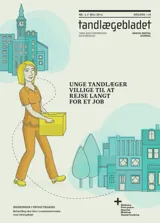Behandling med bidskinner i praksistandplejen i Københavns Kommune
Introduktion og formål
Behandling med bidskinne er en relativt hyppigt forekommende behandling i Danmark af lidelser i mastikationssystemet (TMD). Da der ikke tidligere er publiceret data vedrørende behandling af temporomandibulær dysfunktion i privat tandlægepraksis i Danmark, er formålet med denne undersøgelse at belyse, om behandlingen af disse lidelser er i overensstemmelse med publicerede retningslinjer for klassifikation og behandling og i overensstemmelse med studenterundervisningen i fagområdet.
Materiale og metode
I perioden 1.8.2012- 1.8.2013 blev der fortløbende indsamlet journalmateriale fra privatpraktiserende tandlæger i Københavns Kommune, der på vegne af patienterne ansøgte om økonomisk tilskud til behandling med bidskinne. Journalerne blev gennemgået for registrering af bidfunktionelle variabler, der indgår i anamnese og undersøgelse af temporomandibulær dysfunktion.
Resultater
I ingen journaler var der optaget en egentlig anamnese og udført undersøgelse. Det hyppigste fund var naturligt tandslid beskrevet som gennemslid til dentinen uden nærmere præcisering. Der var heller ikke stillet diagnoser i henhold til ”Klassifikation af temporomandibulære funktionsforstyrrelser og dertil relateret hovedpine og ansigtssmerter” eller de internationale retningslinjer efter ”Research Diagnostic Criteria for Temporomandibular Disorders”.
Konklusion
De mangelfulde og kortfattede journaler viser, at privatpraktiserende tandlæger ikke undersøger og behandler patienter med temporomandibulær dysfunktion i overensstemmelse med gældende retningslinjer og med den undervisning i fagområdet, de har modtaget som studerende. Det er forfatternes opfattelse, at dette er begrundet i, at tandlægerne ikke har opnået den nødvendige rutine og erfaring i tandlægestudiet. Tandslid var den hyppigste årsag til behandling med bidskinne, hvilket kan være problematisk, da det naturlige tandslid i dag sjældent er så kraftigt, at det kræver indgriben med brug af bidskinne.
The use of clinical guidelines for dental splint therapy among private dental practitioners
Introduction and aim – Use of dental splint is a common choice of therapy by dentists in Denmark in the treatment of temporomandibular dysfunction. While no previous reports have been published regarding treatment of temporomandibular dysfunction among private dental practitioners in Denmark, the purpose of the present study was to assess whether treatment by private dental practitioners is in accordance with published national and international clinical guidelines of classification and treatment of temporomandibular dysfunction and in accordance with the pregraduate dental curriculum.
Materials and methods – Ninety-one dental records received from private dental practitioners were described with regard to anamnesis, diagnosis, clinical findings and considerations regarding choice of treatment. The records were consecutively collected in the period 01.08.2012 – 01.08.2013, whenever a citizen in the city of Copenhagen was applying to the municipality for subsidy of treatment with a dental splint.
Results – Not a single record revealed a systematic anamnesis and clinical examination. Furthermore there was not a single case of diagnosis in accordance with the national and international clinical guidelines. The most common recorded clinical sign was tooth wear to the dentine, without further description (69%).
Conclusion – The defective and brief records suggest that private dental practitioners do not examine and treat temporomandibular dysfunction in accordance with the national clinical guidelines and do not benefit from the education at the pregraduate level. Toothwear seems to be the most common cause of treatment with a dental splint, which may be problematic, since natural dental wear on occlusal surfaces is seldom so harmful that the use of a dental splint is required.


